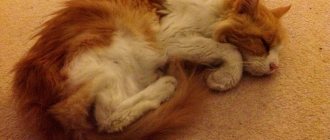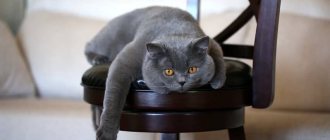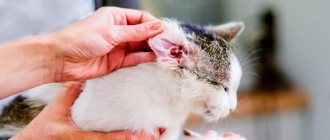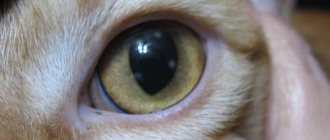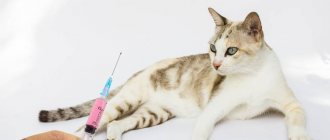Causes of cerebellar ataxia
The main cause of impaired motor coordination in cats is infections that affect the central nervous system and brain. Most often, ataxia develops against the background of panleukopenia.
Loss of coordination is the main sign of pathology
Cerebellar ataxia in cats is a hereditary disease with a genetic predisposition or develops as a congenital form. It can appear as a result of an intrauterine developmental disorder in kittens.
Also reasons may be:
- traumatic brain injuries;
- cerebral edema;
- inflammatory processes;
- damage to the inner ear due to otitis media;
- neuritis of the craniofacial nerve;
- tumors.
Veterinarians include hernias between the vertebrae and spinal cord injuries as possible causes of incoordination in cats.
Otitis in a cat
Should I worry?
Your cat may need more exercise. Set aside time every day to play with her and provide her with toys and puzzles filled with food. Change her toys to new ones periodically so that she doesn't get bored with them.
There are medical reasons why a cat may begin to exhibit this behavior. If an older or lazy cat suddenly becomes abnormally active and restless or behaves strangely, your veterinarian may want to check for any health problems such as feline hyperthyroidism (an overactive thyroid gland).
Older cats suffering from cognitive dysfunction syndrome or dementia may also begin to run around uncharacteristically. Cats that are experiencing physical changes, such as vision or hearing loss, may also begin to arch their back, and if this is a strange behavior for your pet, a visit to the vet is recommended.
Behavioral problems may be related to anxiety or stress, where the cat may become hypersensitive to stimuli in its environment and react by running uncharacteristically. Even flea or insect bites can cause her to arch her back to relieve irritation or severe itching, so check her coat for parasites.
If your cat shows any sudden changes in behavior, it is recommended that you take him to the vet to rule out any medical problems. If her behavior seems unpleasant and there is no medical explanation, seek help from a qualified cat behaviorist.
General group of symptoms for all types
The disease has species-typical and generally similar symptoms. The different symptoms depend on the causes. All types of pathology are characterized by:
- the cat holds its head atypically, it can tilt it to the side or lower it down;
- a staggering gait is observed, the animal loses coordination, the cat can walk, raising its hind legs high.
Epilepsy in cats: symptoms, treatment, how to stop seizures
If the animal's spinal cord is damaged, it will experience pain when walking. Such cats try to hide in a quiet place and move less.
Attention! In severe forms, paralysis of the hind limbs can develop in cats.
With cerebellar ataxia, tremor occurs when running or walking. The kitten will often tremble, and most often the trembling is noticeable only in the back of the body. The cat also has dilated pupils and poor coordination.
If the vestibular apparatus is affected, the cat will suffer from severe headaches. Such animals constantly meow, hide in the corner, pressing their foreheads against the wall.
Hind limb paralysis
Why do Scottish Fold and other cats hump? Is this kyphosis?
It is necessary to distinguish pathology from the norm. The first variant of the norm is when a cat arches its back due to fear. All cats have this property: they try to appear bigger and scarier when they encounter danger. This is also called “standing on end.”
The second variant of the norm is that the cat has a slightly rounded back. This is typical for some breeds, for example Scottish cats. But in this case there are no outgrowths on the back: it is only slightly rounder than that of other cats. It looks like this.
If the back is normal, the cat shows no signs of pain when touched, jumps and runs, and leads a normal life. When do we talk about pathology? When there is pain, when the hump increases in size, when the back no longer looks natural. This is what a cat with a “growth” on its back looks like. Here is an x-ray.
However, you cannot make a diagnosis yourself, because without having the necessary knowledge, it is easy to make a mistake. For example, curvature of the spine in cats is confused with sarcoma. This is a tumor that needs to be removed.
Localization of damage in ataxia
Stroke in cats: symptoms and treatment, first signs
Depending on the location of the source of inflammation, the pathology is divided into the following groups:
- Cerebellar - appears with inflammation of the medulla oblongata and cerebellum. The disease can be either congenital or acquired.
- Vestibular - with inflammation of the inner ear system.
- Proprioretic - a form caused by damage to peripheral nerves.
- Spinal cord develops against the background of damage to the spinal cord.
In veterinary medicine, there are two forms of ataxia:
- static;
- dynamic.
In the first case, the kitten will not even be able to stand straight; in the second, on the contrary, coordination is impaired only during movement.
Pathology in kittens from birth
Symptoms and diagnosis
In general, the symptoms of ataxia in cats are simple. The pet looks like a drunkard, he shakes, the cat cannot walk normally, in severe cases he falls on his side with a roar, just trying to sit down. A constant tilt of the head to one side, as well as erratic circular eye movements, are very typical. Other symptoms may vary depending on the underlying cause of the ataxia. For example, a cat “under mint” can walk with a wobbling gait with its head held high; from time to time, it shakes it and generously splashes saliva around. It looks terrible, but goes away quickly.
Your veterinarian will perform a complete physical examination of your cat. The information provided by the cat's owner is important. It is advisable to remember the following:
- Did the animal have access to household chemicals, poisons, or was deratization (rodent extermination) carried out in your home or area?
- Is there any information in your pet’s pedigree about any pathologies that the cat’s parents suffered from?
- Did the cat fall from the balcony, did it get hit by a bicycle, etc.
It is very important to remember all the cases of illness that your pet has suffered. It is advisable to tell us if you have tried to treat it yourself by “prescribing” any medications.
A blood test is very important, which will allow you to determine whether there is a deficiency of any important micro- and macroelements and vitamins. X-rays and ultrasound are also used, with the help of which tumors, the presence of parasites, and other serious problems are detected.
Types of ataxia
Depending on the area of damage, there are two main types of pathology.
Sensitive ataxia (proprioceptive)
Idiopathic cystitis in cats: symptoms and treatment
This form of the disease occurs due to damage to the spinal cord or peripheral nerves. The occurrence of the disorder may be influenced by the presence of a tumor in the intervertebral discs in the cat.
The animal loses the ability to flex and extend its paws at the joints. It cannot consciously choose the direction of its movement. The cat is experiencing severe pain in the back and neck. In severe forms of the pathology, the cat cannot move completely.
Attention! If the brain is only partially damaged and treatment is given early, your pet has a chance of a full recovery.
Vestibular ataxia
The diagnosis of vestibular ataxia is made if the inner ear system is affected and there is also a tumor of the brain stem. Pets over ten years of age most often get sick. The cat cannot stand, it falls on its side. The head tilts towards the affected side. The animal moves very slowly and carefully. Vomiting is sometimes observed.
Vestibular ataxia can occur due to:
- development of a brain tumor;
- otitis media;
- infections;
- injuries when cleaning ears;
- drug overdose.
Important! The first sign of pathology is that the cat is sitting in the corner, leaning its forehead against the wall.
Signs of vestibular ataxia
The cat staggers when walking: otitis media
The balance is mainly found in the ear, and imbalances that occur in the ear or nervous system can cause ataxia, a disorder that can be the cause of the problem if our cat wobbles when walking.
Thus, we must rule out an ear infection: otitis media. Otitis media can occur for a variety of reasons, such as a buildup of mites that infect the ear.
Although mild infections and infections of the outer ear do not cause these symptoms, otitis media can become more complicated and affect the middle ear, which can lead to ataxia, which can be the cause of our pet's imbalance if our cat wobbles when walking.
These ear infections can also be caused by a blow or even a foreign body in the ear. A typical case is thorns, an unknown danger to your cat that causes severe pain and serious ear infections.
© shutterstock
Diagnosis of ataxia in a cat
The main stage in diagnosing pathology is a complete history taking. The veterinarian must determine whether the animal had injuries or whether it suffered from infectious diseases. If possible, find out information about heredity and the course of pregnancy if we are talking about pathology in a kitten.
The animal's nervous system is assessed and tests are taken to identify viral pathogens. It is recommended to do an MRI of the brain to see tumors or areas of bruising. It is necessary to examine the ears using an otoscope.
As soon as there is a suspicion that infection is occurring in the area of the brain or spinal cord, a test for leukocytes in the cerebrospinal fluid is required.
Diagnosing disease in pets
Establishing diagnosis
The cause of the disease is determined by the doctor based on clinical symptoms and a thorough history. The owner informs the veterinarian about previous injuries, nutrition, previous diseases, pedigree, information about the presence or absence of similar ailments in relatives. It is necessary to find out whether the mother cat was vaccinated before mating.
In severe cases, the cat is unable to feed itself.
To clarify the diagnosis, a veterinary neurologist is involved. They conduct tests for viral diseases of cats, ultrasound, x-rays, MRI. The ears are examined using an otoscope. If necessary, cerebrospinal fluid is collected for analysis. Blood and urine tests are performed to exclude or confirm the presence of diseases with similar symptoms.
Treatment of cerebellar ataxia in cats
The chances of recovery and treatment methods for feline ataxia depend on the general condition of the animal and the reasons that caused the development of the pathology. The cat has the opportunity to fully recover and return to a healthy lifestyle if the owner consults a veterinarian in a timely manner.
The measures taken by veterinarians when diagnosing ataxia may be as follows:
- If the pathology is caused by a tumor, surgery is used. After its removal, the symptoms disappear.
- In case of poisoning, measures are taken to relieve intoxication. The animal is prescribed IVs, injections of vitamin B1, and diet.
If the pathology occurs against the background of brain defects, it can occur in mild, moderate and severe forms. The disease cannot be cured, but in mild cases it is possible to save the kitten. This will require full-time care.
Kittens are prescribed the drug "Gamavit" to strengthen the immune system. To improve the functioning of brain tissue, Glycine is recommended at a dosage of 250 mg, 1 tablet per day. The course of admission is 14 days.
Most often, the condition stabilizes after the kitten turns one year old.
Treating a pet for poisoning
Reasons in food
Food may also be associated with this type of process: cheap food may lack various minerals and proteins, which can cause this type of weakness.
This is why we should always take extra care when feeding our pets and finding the best cat food. The juvenile and geriatric stages are especially important, so senior pet or kitten food must be given to our pets during these life stages to avoid suffering from diseases caused by deficiency.
© shutterstock
Treatment on an outpatient basis and at home
It is important that therapy is carried out comprehensively. The treatment regimen is developed depending on the cause that caused the development of the disease. In this regard, the dosage of drugs may differ even if we are talking about the same form of pathology.
The following medications are most often prescribed:
- vitamin complexes, B vitamins;
- to eliminate infections - antibiotics;
- for swelling of the brain - diuretics;
- Hepatoject for liver dysfunction;
- to improve blood circulation in the brain - Cerebrolysate;
- saline solutions in droppers to relieve intoxication.
Physiotherapy and massage are recommended for the animal. If the spinal cord is affected, surgery is required.
Important! You should not try to treat yourself. A sick animal requires professional advice from a veterinarian. The severe form cannot be eliminated using folk methods alone without an integrated approach.
Vitamins for full recovery
Treatment
Ataxia can only be treated with medication. However, only a veterinarian can identify the cause of the disease. Additionally, a special diet is prescribed. If ataxia is secondary and provoked by other pathologies, then they are treated first. In extreme cases, surgery is performed.
First aid
First aid for ataxia is to contact a veterinarian. For proper treatment, it is necessary to establish the cause of the disease. If the cat has a congenital pathology, the doctor will prescribe medications that can help relieve the symptoms. Veterinarians advise providing your pet with proper care. This reduces the risk of symptoms and complications.
Basic treatment
The main treatment for ataxia is medication. Tactics depend on the cause of the pathology. Additionally, physiotherapy methods, massage, and surgical operations can be used. The treatment regimen includes vitamins B and B12. To strengthen the immune system, Gamavit is prescribed. Proserin helps restore nerve conduction.
Cerebellar ataxia is difficult to treat due to brain degeneration. Cerebrolysin is prescribed to improve tissue regeneration and blood circulation. To restore brain function, Glycine is prescribed. It is shown in courses of two weeks. The cat should be given Caviton or Piracetam for 7 days. If the disease has affected the spinal cord, then physiotherapy (UMI, UHF), massage, or surgery is prescribed.
If the cause is an infection, then the pet is given antibiotics (Vancomycin, Ampicillin). Infusion of saline solutions (a dropper is given) with glucose and glucocorticosteroids (“Prednisolone”) help to cope with intoxication of the body. When the cause is hydrocephalus or cerebral edema, the diuretics Veroshperon or Furosemide are prescribed.
Diazepam helps to cope with severe tremors in cats. The drug is given in small doses, as it is highly toxic to the liver. With cerebellar ataxia, the cat’s condition stabilizes by the age of one year. However, they require more careful care than healthy pets.
Prevention of ataxia
Despite the complexity and severity of the pathology, pet owners can create the necessary conditions to avoid its development. First of all, it is necessary to avoid any factors that could lead to injury. It is not recommended to let your animal go outside unattended.
The following should be used as preventive measures for the development of ataxia:
- Timely contact a veterinarian if there is a suspicion that the animal has a traumatic brain injury.
- Vaccinations in accordance with the schedule against leukemia, panleukopenia.
- Treatment of inflammation in the ear canals is mandatory.
- Examine the cat for panleukopenia before mating is planned.
- During pregnancy, protect the cat from contact with other animals.
Massage for cats
Important! Loss of coordination can be effectively treated through physical therapy. Veterinarians recommend working with your pet and provoking it to play. Activity is very necessary for a kitten with ataxia.
Ataxia in cats is a complex disease, but with a competent and timely approach, the pet owner can return it to normal life. Caring and adherence to preventive measures effectively influence the healing process.
When does this happen?
It comes out of nowhere. Sometimes the cat seems to “see” something invisible and starts running, or it may be in a playful mood, which may be aggravated by play. Cats also practice their stalking, hunting, and chasing behaviors, and this can cause them to arch their backs. There can be many reasons for this. After all, running is fun!
Kittens and young cats are more likely to fall into this state as they are full of energy and this can be a way of burning off excess energy. But sometimes even older cats can arch their back. Cats sleep most of the day when their owners are at work, so when they return home, the animals are awake and full of pent-up energy.
Humpback and kyphosis: causes
In the case of a pathology called kyphosis, acquired and hereditary varieties are distinguished.
Congenital kyphosis occurs as a result of abnormal development of the anterior part of the vertebrae. In particular, congenital kyphosis can occur due to improper selection of a pair of parents. For example, in the Scottish breed it is allowed to cross only Folds with Straights (these are two varieties of Scottish cats): Scottish cats cannot be mated with other breeds. There are other rules for selecting a couple. Sometimes kittens have a hunched back due to improper selection of parents for breeding.
Genotypic kyphosis is inherited from parents. The “humpback gene” is dominant: if one of the parents has it, the kittens will also be humpbacked. Therefore, competent breeders exclude humpback cats and cats from breeding programs.
Compression kyphosis can result from a compression fracture of the spine. This curvature looks like an angle with the apex up (angular kyphosis).
Tuberculous kyphosis appears due to the destruction of the vertebral bodies and their compression. Tuberculous kyphosis is also angular.
Mobile kyphosis is the result of weak back muscles.
Rachitic kyphosis accompanies a disease such as hyperparathyroidism and usually appears before 5 months. Hyperparathyroidism, in turn, is caused by improper feeding, and also appears in kittens in the womb due to problems in the mother’s body.
Senile kyphosis is caused by age-related degenerative-dystrophic changes in the spine and/or muscle weakening, which is typical for older animals.
To diagnose kyphosis and determine the type, the veterinarian first examines and palpates (palpates) the patient, then prescribes an x-ray and sometimes a myelogram (analysis of the contents of the bone marrow after taking a puncture).
A verdict is made only based on research. If the veterinarian did not do this and made a diagnosis only on the basis of an examination, you should contact another specialist.
What diagnostic measures may be required?
During the initial examination, the veterinarian collects a complete history of the animal (symptoms of pathology, the pet’s lifestyle, age, presence and absence of other diseases, etc.). Based on the medical history, the doctor already determines a list of diagnostic measures and tests.
Diagnostics may include:
- MRI of the head;
- urine and blood analysis;
- hearing test;
- X-ray of the head;
- examination of the animal;
- test for nervous system reactions.
Almost all of the above activities are carried out at the first appointment, except for tests.




